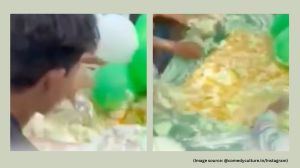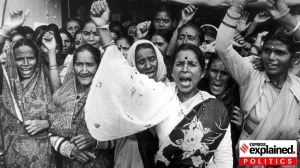The batalik battle
It wasnt just the enemy that Brig Devinder Singh,who got a well deserved pat from the then Army chief for winning Batalik,was fighting against. He was also confronting a bias by a top commander. MANU PUBBY reconstructs the battle and the story of the war hero
The operations in Batalik have come under the scanner after a tribunal ruling that one of the senior most officers involved in the Kargil war,15 Corps Commander Lt Gen Kishan Pal,fudged the battle performance reports of his junior,Brigadier Devinder Singh,who was leading troops in the sector. Singh,incidentally,was the first officer to have introduced heavy artillery,including rocket launchers,against the intruders that later became the standard practice in the war.
Eleven years ago,Batalik saw some of the fiercest battles during the Kargil war and was a success story,given that most of the Pakistani arms and ammunition,besides six prisoners of war,were captured from this sector. One of the Param Vir Chakras,to Lt Manoj Kumar Pandey,was awarded for the attack on the Khalubar ridge on the sector.
The point of contention,for many years,remained on who should to be credited for operations in the sector that resulted in the killing of over 300 enemy personnel. While most records and written accounts of the war have given the credit to Brigadier Devinder Singh,the commander of the 70 Infantry Brigade,the official war history till now also credited another officer,Brigadier Ashok Duggal for managing a part of the operations in the sector. Interestingly,Duggals name was added only by Lt Gen Kishan Pal in his post-war report.
At the centre of the controversy is Lt Gen Pal,who,as the 15 Corps Commander,was responsible for the security of the entire line of control along the Kashmir Valley and the Ladakh region. Under his command was the 3 Infantry Division that was responsible for the Drass-Kargil-Batalik area with three brigades. While the 114 Brigade was deployed on the Chinese Line of Actual Control,the 121 Brigade was at Kargil,and 70 Brigade was responsible for Batalik.
Brigadier Devinder Singh,an officer with an outstanding record who had topped most courses during his years at the academy,was commanding the 70 Brigade. But with all his battalions deployed for counter-insurgency operations in the Valley,it was designated as the Corps reserve. When reports of intrusions at Kargil came in,Brig Singh asked for battalions to be deployed under his command as he feared that more than 600 fighters had intruded into Batalik.
However,Lt Gen Pal kept downplaying reports of intrusions in Batalik and contended that only 45 militants had come into the area. Operations in Batalik began in May 1999 after Brig Singh was given the 1 Bihar battalion to carry out operations. By that time,reports pointed to intrusions by the troops of the 5 Northern Light Infantry of the Pakistani Army in the unheld area. Regular Pakistani Army soldiers had moved as much as 8-10 km in the sector and occupied several abandoned bunkers and created defences. Pakistani troops,aided by militants,had trekked for several days in deep snow to occupy four major ridge lines that dominated the area.
Aided by the knowledge that the Indian Army did not have a permanent presence in the area and used to carry out limited patrols in the warmer months,supplies were brought in for the intruders by mules and porters. So audacious was the intrusion that supplies were even being dropped by Pakistani Armed Forces helicopters before the Indian Army troops moved in.
The objective of the intrusion was dominance of the Leh-Batalik-Kargil road. Control of the Batalik sector would have ensured that the strategic road the lifeline of the Siachen glacier would be under constant observation and within the firing range,squeezing supplies to the glacier.
While Brig Singh and his troops arrived in time by mid-May to ensure that the intrusion did not extend to the strategic road,the Army was faced with the daunting task of dislodging more than 700 enemy fighters from strongholds that had been established at heights ranging from 15,000 to 16,800 feet.
The Pakistani troops had established positions along four main ridge lines Jubar,Kukarthang,Khalubar and Churubar Po. The Indian tactic was to concentrate adequate troops in Batalik and counter attack the enemy with heavy artillery followed by an infantry assault. The problem was identifying the heavily fortified enemy positions and cutting off their supply lines to isolate the fighters.
The first contact came on May 29 when troops of the 1 Bihar attacked Pt 4262 on the western flank. However,the unit faced heavy casualties and lost Major M Saravanan after he personally led an attack to capture the enemy bunkers.
The feature had to be abandoned due to heavy casualties,but one of the documents recovered gave one of the first concrete proofs of the involvement of regular Pakistani Army troops in the battle. From one of the bunkers captured by Major Saravanan the pay book of a regular Pakistani Army soldier was recovered.
After it was ascertained that there was,in fact,heavy infiltration in the Batalik sector as predicted by Singh,additional troops were rushed in to aid operations in the area. While none of the units were ones that Singh was familiar with they had been hastily pulled in from other formations to aid in the operations they were quickly deployed into action along the four ridge lines in the sector.
Even though Singh was able to mesh together the string of different units he was given,his inter-personal relations with Lt Gen Pal remained strained. One of the reasons,old timers recall,was the initial period during which Singh insisted that there was heavy intrusion in Batalik while Pal played it down repeatedly.
Things came to a showdown when the then Army chief General V P Malik visited Batalik in June and was told by Singh that more than 600 regular Army fighters were present. However,Pal countered this by saying that only 45 militants were holding the heights.
One of the new units rushed in after it became clear that the enemy strength exceeded 600 was the 12 JAK Light Infantry that was in the process of being de-inducted from Ladakh. The acclimatised battalion was quickly deployed to cut through the enemy defences and drive a wedge through their positions to isolate them from each other.
As fresh units came pouring in Ladakh scouts,10 Para and 5 Para the enemys supply route to the Khalubar ridge from the east was cut off,leaving it more vulnerable.
The capture of the crucial Pt 5390 gave the Indian Army a crucial observation point that was used to direct artillery fire on enemy positions.
Throughout the period,Brig Singh led his troops from the front. While he came under some criticism for unnecessary bravado,his leadership skill was appreciated by the Army chief. In his book on the war,General Malik says Singh was injured while directing operations at a forward position,but he merely went in for some first aid and carried on with his duties till the end.
Assaults were carried out on the Stangba-Khalubar ridge line by troops of the 70 Brigade that were supplemented with the entry of the 22 Grenadiers and the 1/11 Gorkha rifles. The first Pakistani prisoner of war,Naik Inayat Ali,was captured on the Khalubar ridge line after troops from the 12 JAK Light Infantry captured Pt 4812.
It was also on Khalubar that Lt Manoj Kumar Pandey,a young officer of the 1/11 Gorkha Rifles,led his troops to capture enemy positions and personally cleared three bunkers before succumbing to injuries. The officer,who provided the Gorkha regiment the key advantage that led to the capture of Khalubar,was awarded the highest gallantry award of the country the Param Vir Chakra. It is the credit for leading fight on this ridge line,considered to be the first major breakthrough by the Army in Batalik that was under contention.
While Brig Singh was commanding the troops,in the post-war records,Lt Gen Pal noted that the Brig Duggal the deputy GOC of 3 Div was in charge of the sector.
The tribunal has now set the record straight by ruling that Singh was in charge of the entire sector throughout and has asked the Army to moderate the paragraph in the official history that mentions Brig Duggal as the man in charge.
Insiders say that one of the fallouts of the strained relations between Singh and his superior was that Lt Gen Pal tried to play down Singhs role in the victory at Batalik. As the tribunal has noted,Dugal was,in fact,temporarily deployed for 72 hours to assist and coordinate operations in the area.
The battle raged on in the sector and subsequently,the division met with successes at Jubar,Chorbat La and Tharu. Here again,Brig Singhs background as an artillery officer came into use. For the first time during the war,122 mm multi barrel rocket launchers (MBRLs) were used to direct fire at enemy positions on Jubar and Tharu. While commanders in other sectors had shied away from employing MBRLs in mountain areas,Singh deployed his launchers close to a pass on the Kargil road that was at the same height of the enemy positions.
The pulverising effect of the MBRLs gave the Army a psychological edge over the enemy. By July 9,after 155 mm Bofors Howitzers and medium guns of the 3 Artillery Brigade were also employed,almost the entire Batalik sector had been cleared of enemy fighters.
In his book,General Malik notes that he gave a well deserved pat to Brig Singh along with a bottle of Scotch whisky,as a small personal gesture of appreciation after the operations in Batalik virtually came to an end by July. This personal gesture and appreciation by the Army chief notwithstanding,in three years time,Singh had to file a statuary complaint after he realised that he would be overlooked for promotion as his annual report reviewed by Pal showed him in poor light. While most of the notings by Pal have been expunged by the Defence Ministry in past years,the fact remains that Singh was not only overlooked for promotion he retired as a Brigadier even after leading his troops to victory in Batalik but was also awarded only the Vishisht Seva Medal (VSM),a peacetime medal,instead of the Maha Vir Chakra,the second highest wartime gallantry award that he was recommended for.



- 01
- 02
- 03
- 04
- 05




























